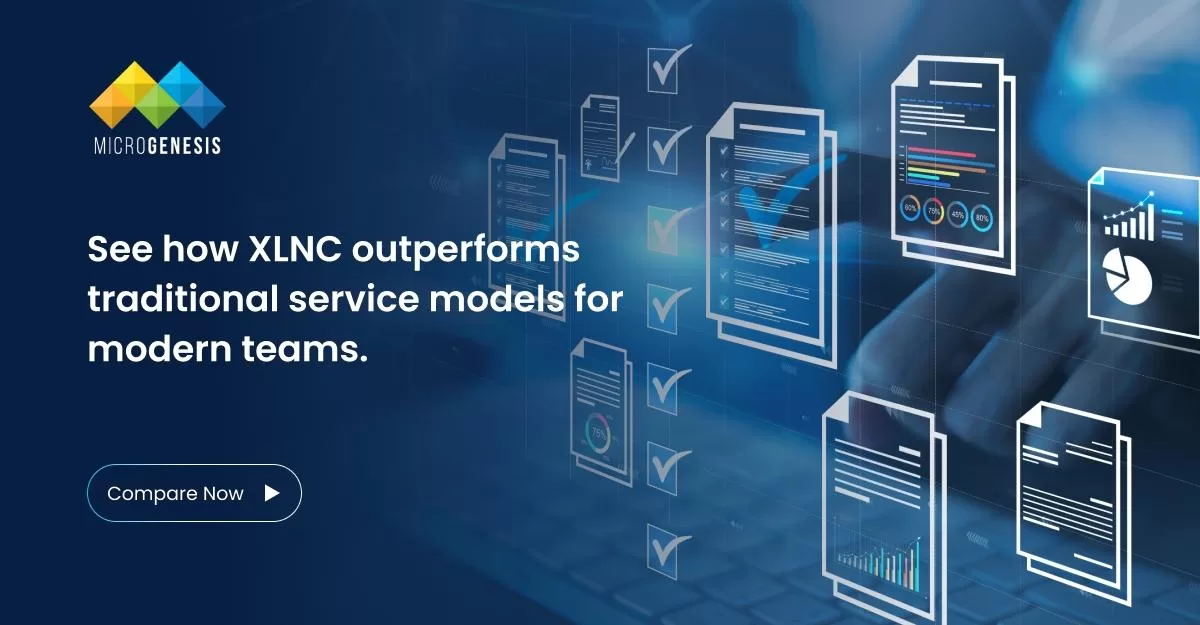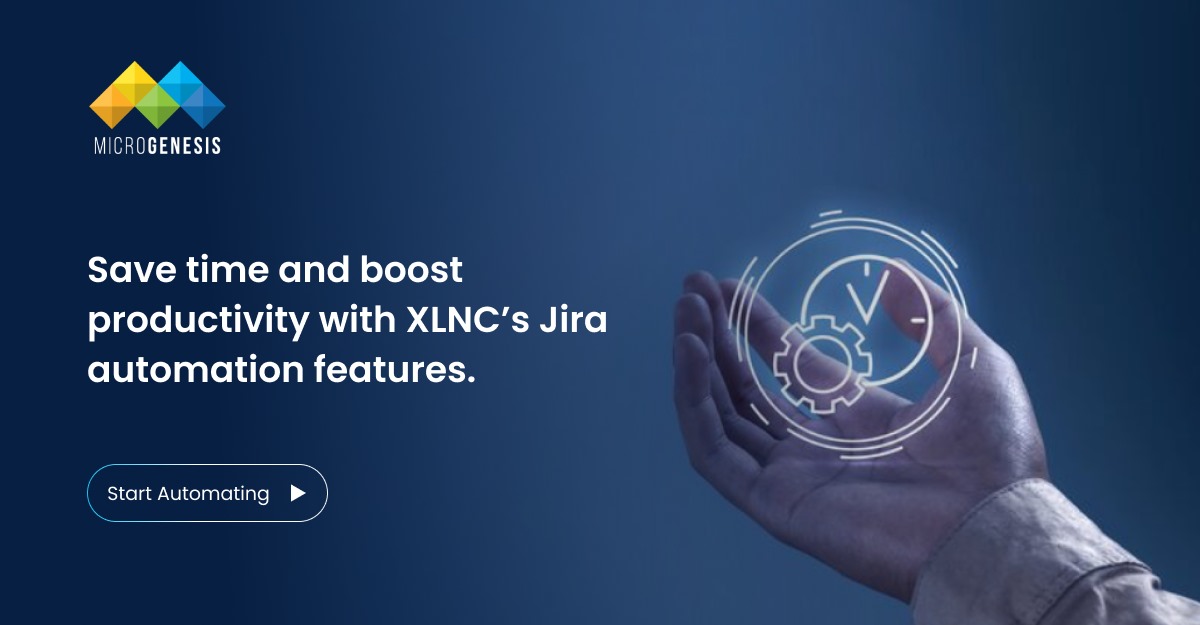Model-Based Systems Engineering
BROWSE TOPICS
Introduction
Model-Based Systems Engineering (MBSE) has emerged as a critical methodology for managing the complexity of modern systems. Unlike traditional document-centric approaches, MBSE leverages models to support the entire lifecycle of system development, from initial concept through to deployment and beyond. This approach has gained traction due to the increasing adoption of digital-modeling environments, which provide a more integrated and efficient way of handling the intricate demands of system engineering.
What is Model-Based Systems Engineering (MBSE)?
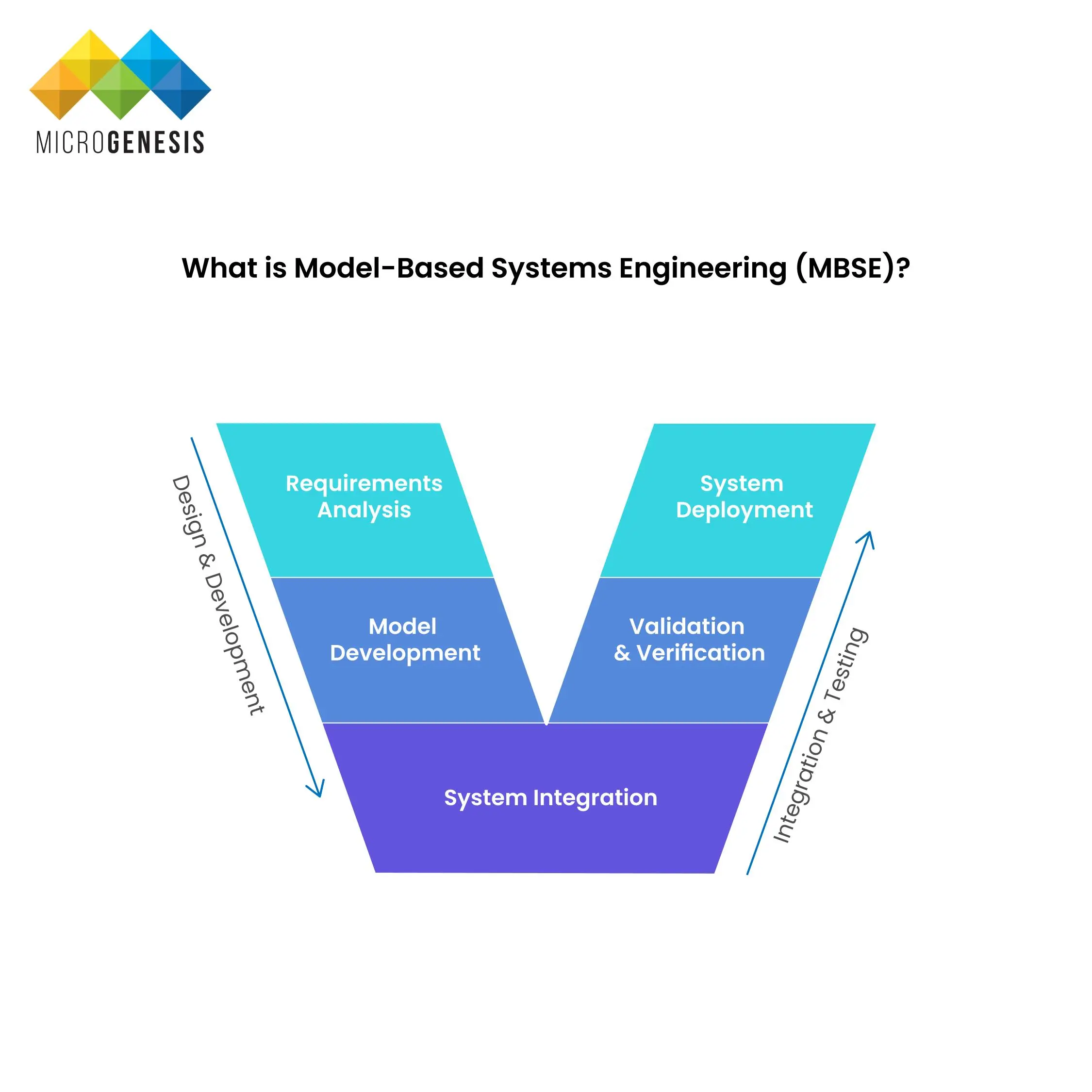
The Rise of MBSE in Modern Engineering
The adoption of MBSE has accelerated in recent years, driven by the increasing complexity of systems and the need for more reliable and efficient development processes. For instance, NASA noted in January 2020 that MBSE “has been increasingly embraced by both industry and government as a means to keep track of system complexity.” The shift towards MBSE is further fueled by advancements in digital-modeling environments, which offer powerful tools for creating, managing, and analyzing system models.
MBSE and Cybersecurity
One critical application of MBSE is in the realm of cybersecurity. The SEI CERT Division has begun exploring how MBSE can be used to address security risks early in the system-development process. By capturing system attributes in models, engineers can perform threat-modeling analysis at the design stage, enabling the incorporation of mitigation strategies that reduce overall security-related risks. This approach contrasts with the traditional practice of adding security features later in the development process, often leading to vulnerabilities and inefficiencies.
Advantages of MBSE in a Digital-Modeling Environment
MBSE in a digital-modeling environment offers several key advantages over document-based systems engineering:
- Single Source of Truth: In a document-based approach, multiple documents are generated by different authors, each capturing different stakeholder views of the system. MBSE, however, creates a single source of truth where all discipline-specific views—such as system behavior, software, hardware, safety, and security—are derived from the same model elements.
- Standards-Based Approach: A digital-modeling environment provides a common standards-based approach to documenting the system. This can be programmatically validated to eliminate inconsistencies and enforce the use of standard practices across all stakeholders, improving system analysis and reducing defects.
- Consistency Across Disciplines: The availability of digitalized system data for analysis across disciplines ensures consistent propagation of corrections and the incorporation of new information. This enhances collaboration and ensures that all stakeholders are working with the most up-to-date and accurate information.
- Reduction of Development Risks: When implemented correctly, MBSE reduces development risks by providing a clear and consistent framework for system design, verification, and validation. This leads to fewer errors, reduced rework, and more efficient development processes.
Key Concepts in MBSE
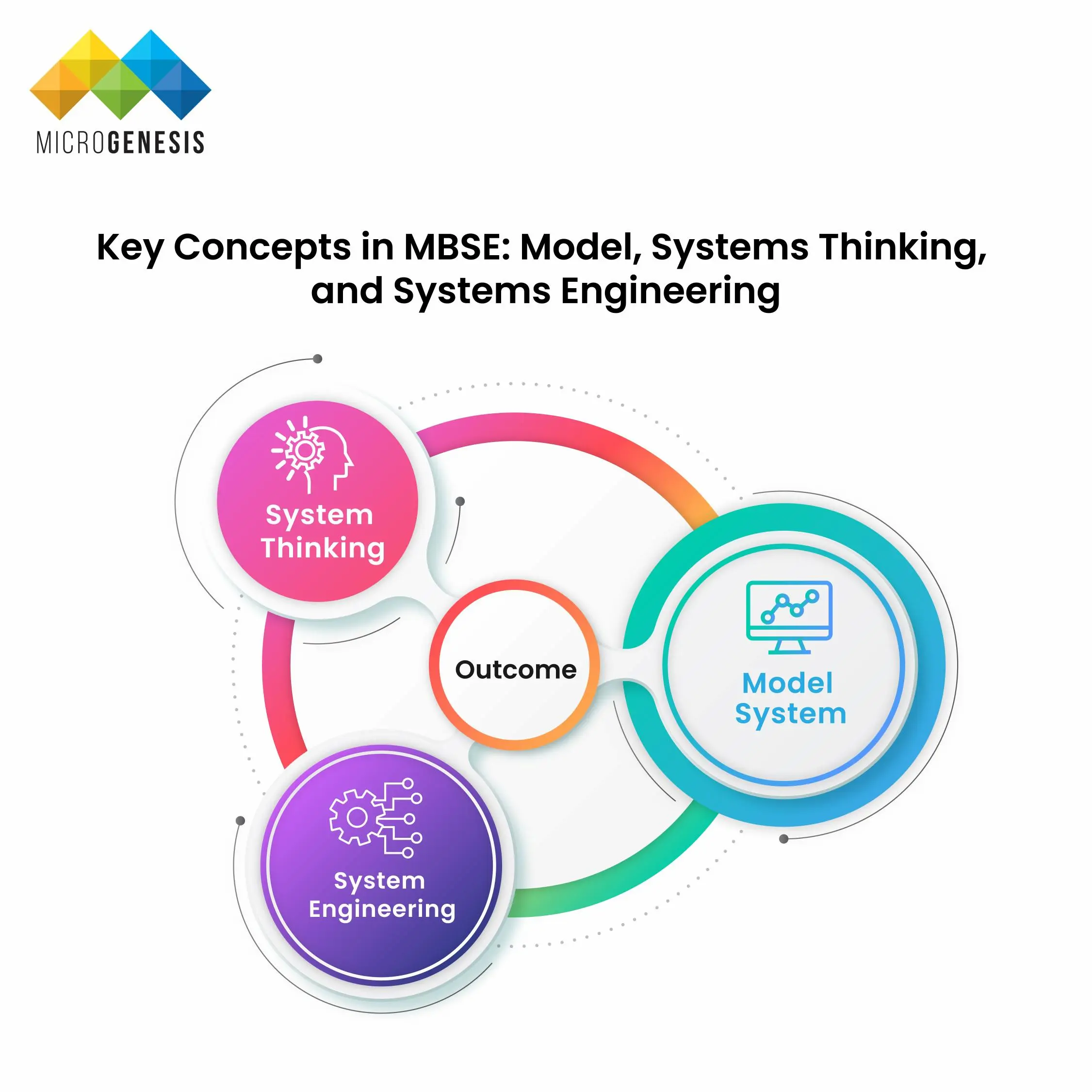
MBSE brings together three fundamental concepts:
- Model: A model is a simplified representation of something, whether it’s graphical, mathematical, or physical. It abstracts reality to eliminate complexity, making it easier to understand and manage. In MBSE, models should sufficiently represent the system, providing clarity on its structure and behavior.
- Systems Thinking: Systems thinking is an approach that views a system as part of a larger interconnected whole. It emphasizes understanding the system’s context, lifecycle, and interdependencies, enabling engineers to manage complexity and identify issues that may not be apparent at first glance.
- Systems Engineering: Systems engineering is a transdisciplinary approach that integrates various methods and principles to ensure the successful realization of complex systems. It covers all aspects of the system lifecycle, including architecture, implementation, integration, analysis, and management.
Modeling in MBSE
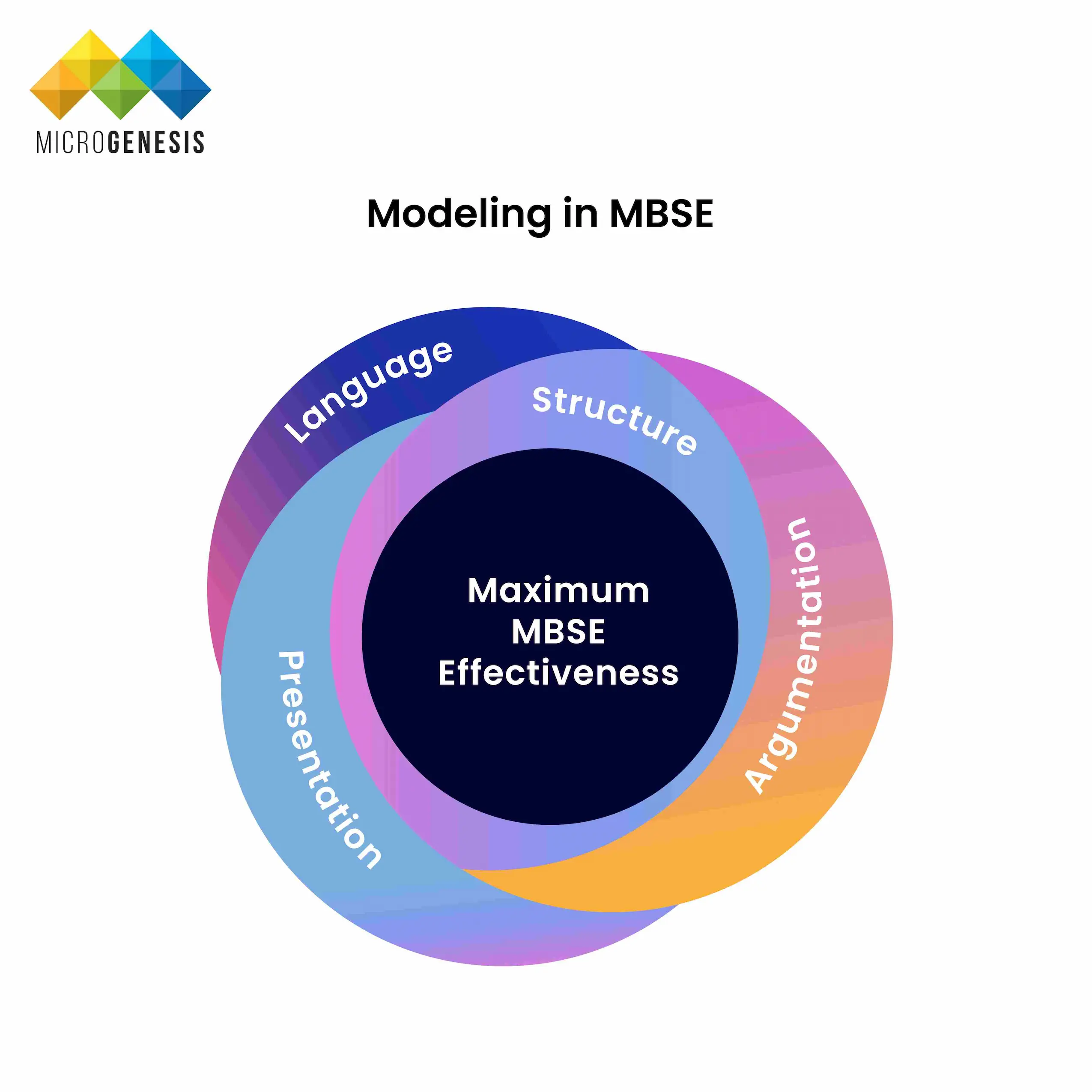
Modeling is a fundamental technique in MBSE, involving the use of language, structure, argumentation, and presentation:
- Language: A modeling language provides a common terminology for clearly communicating abstract ideas. Examples include the Systems Modeling Language (SysML), Unified Modeling Language (UML), and Architecture Analysis Design Language (AADL). SysML, with its strict syntax and rules, is particularly suited for creating formal models that avoid ambiguity.
- Structure: A well-structured model is essential for making the model understandable, usable, and maintainable. The structure should demonstrate how the system’s design satisfies its requirements in a comprehensible way, often through visualization.
- Argumentation: Argumentation in modeling involves the logical reasoning behind the model’s structure and behavior. It ensures that the model’s design decisions are justified and traceable back to the system’s requirements.
- Presentation: Effective presentation of models helps stakeholders visualize and understand the system. This is critical for ensuring that the system meets its intended purpose and that all stakeholders are aligned with the design.
Modeling Domains in MBSE
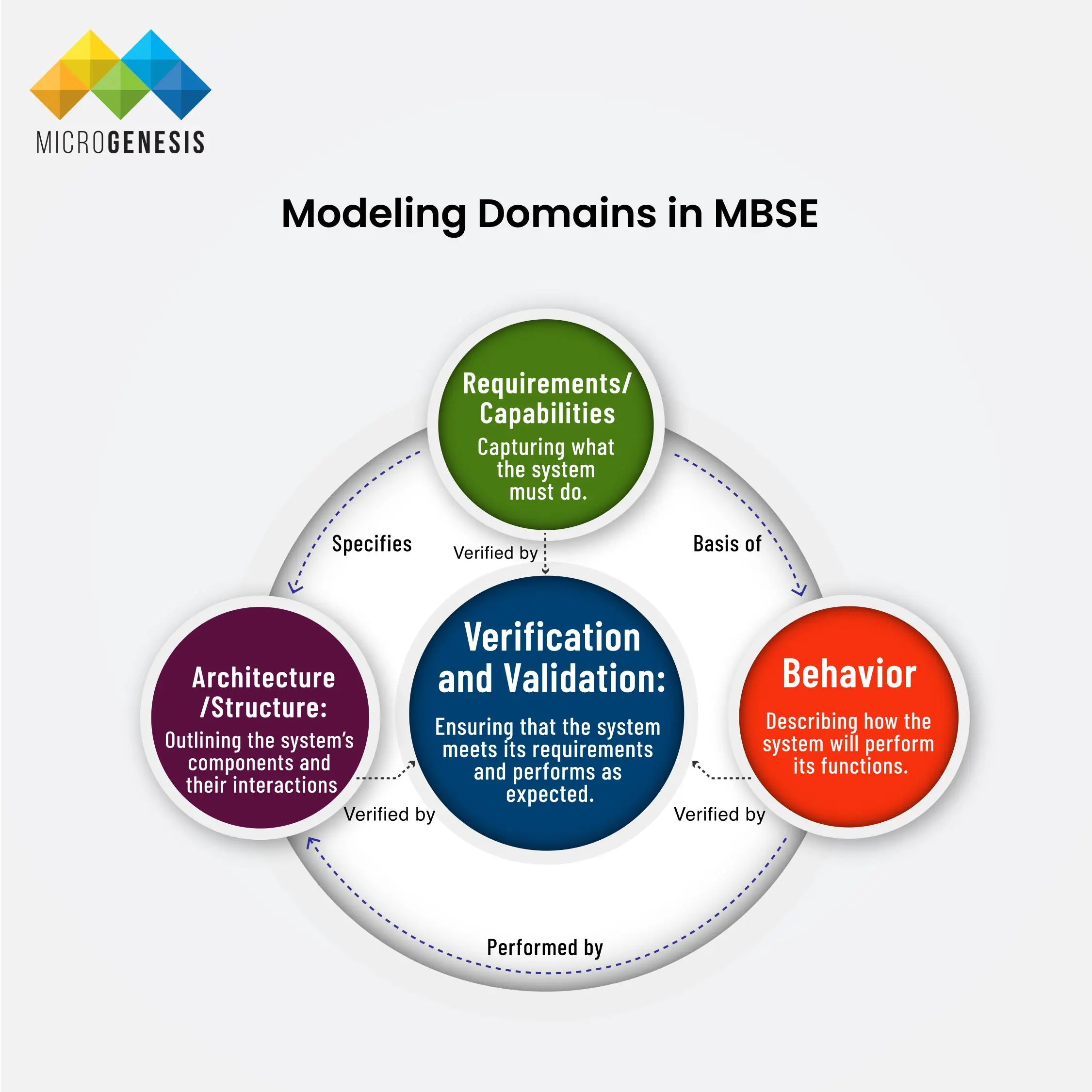
MBSE encompasses four key systems-engineering domains:
- Requirements/Capabilities: Capturing what the system must do.
- Behavior: Describing how the system will perform its functions.
- Architecture/Structure: Outlining the system’s components and their interactions.
- Verification and Validation: Ensuring that the system meets its requirements and performs as expected.
These domains are represented in the model itself, providing a formal way to document and analyze the system.
- Operational Point of View (Logical)
- Purpose and Focus:
- Key Components:
- Business Processes:
- Objectives:
- Organizational Structure:
- Use Cases:
- Information Flows:
- Importance:
- Operational Point of View (Physical)
- Purpose and Focus:
- Key Components:
- "As-Is" State:
- "To-Be" State:
- Contextual Considerations:
- Importance:
- System Point of View (Logical)
- Purpose and Focus:
- Key Components:
- System Architecture:
- Behavioral Models:
- Data Flows:
- Functional Decomposition:
- Importance:
- System Point of View (Physical)
- Purpose and Focus:
- Key Components:
- Physical Architecture:
- Deployment Strategies:
- Solution Alternatives:
- Integration and Interfaces:
- Importance:
This quadrant addresses the logical aspects of the system from the perspective of the users, operators, and business stakeholders. It focuses on understanding the needs and expectations of these stakeholders by examining business processes, objectives, organizational structure, use cases, and information flows. The goal is to define what the system needs to achieve without getting into the specifics of how it will be implemented.
Detailed descriptions of the workflows and activities that the system will support or enhance. This includes identifying key stakeholders, roles, and responsibilities within the organization.
High-level goals that the system is designed to meet, such as improving efficiency, reducing costs, or enhancing user experience.
The arrangement of teams and departments that will interact with or be affected by the system. Understanding this structure is essential for aligning the system with business needs.
Scenarios that describe how different stakeholders will interact with the system to achieve specific goals. Use cases help to clarify the functional requirements of the system.
The movement of data and information within the organization, including how information is generated, shared, and used by different stakeholders.
The logical operational view provides a clear understanding of what the system must accomplish from a business perspective. It serves as the foundation for defining the system's requirements and ensures that the system aligns with the organization's goals and processes.
This quadrant focuses on the physical aspects of the system's operation within its real-world context. It describes the current ("as-is") state of the system and the desired future state ("to-be") after the system is implemented. This includes considerations of how the system will fit within the existing operational environment and any changes that may be needed to accommodate it.
A detailed description of the current operational environment, including existing systems, processes, and infrastructure. This helps in identifying potential challenges or limitations that the new system must address.
A vision of the future operational environment, detailing how the system will function once implemented. This includes any modifications to existing processes, integration with other systems, and changes in the operational workflow.
The physical environment in which the system will operate, including factors such as location, hardware constraints, network infrastructure, and external dependencies.
The physical operational view ensures that the system is designed with a clear understanding of its real-world environment. It helps in planning for the transition from the current state to the future state, ensuring that all necessary changes are accounted for and that the system will function as intended within its operational context.
This quadrant represents the logical aspects of the system’s architecture, behavior, and functionality. It defines the system's structure in terms of components, their interactions, and the data flows between them. This view abstracts away from the physical implementation details, focusing instead on how the system should logically function to meet the requirements defined in the operational views.
A high-level overview of the system’s structure, including its major components, subsystems, and their relationships. This includes both static structures (e.g., components and their hierarchies) and dynamic interactions (e.g., data flow and control flow).
Detailed descriptions of how the system behaves in response to various inputs, events, and conditions. This includes state diagrams, sequence diagrams, and activity diagrams that depict the system’s functionality over time.
The logical flow of data between different components and subsystems. This includes defining data types, interfaces, and communication protocols used within the system.
Breaking down the system’s high-level functions into smaller, manageable tasks or operations. This helps in understanding how different parts of the system contribute to overall functionality.
The logical system view provides a blueprint for how the system should work in theory, without being constrained by physical considerations. It is crucial for ensuring that the system’s design meets the operational requirements and that all components work together cohesively to achieve the desired outcomes.
This quadrant details the physical implementation of the system, describing how the logical design will be realized in the real world. It includes the selection of hardware, software, and other physical components, as well as the deployment strategies that will be used to bring the system to life. This view also considers alternative solutions and their potential impact on the system’s performance and scalability.
The actual hardware, software, and network infrastructure that will be used to implement the system. This includes details on servers, storage, network devices, and other physical components that will support the system’s operation.
Plans for how the system will be rolled out, including timelines, resource allocation, and potential risks. This also covers considerations for scaling the system, maintenance, and future upgrades.
Analysis of different possible implementations of the system, weighing the pros and cons of each. This may include cost-benefit analysis, performance considerations, and impact assessments for each alternative.
How the system will interface with other systems, both internally and externally. This includes integration with legacy systems, third-party services, and any required data migration.
The physical system view ensures that the logical design is translated into a working system that can be deployed and operated in the real world. It provides the necessary details for system engineers to build, integrate, and maintain the system, ensuring that it meets both functional and non-functional requirements.
Interconnection and Traceability Between the Quadrants
All four quadrants must be tightly interconnected to ensure that the system is designed and implemented in a way that meets all requirements and operates effectively within its intended environment. Traceability is a key concept in MBSE, allowing for the seamless flow of information between the quadrants. For example:
- From Problem to Solution:
- Logical to Physical:
- Feedback Loops:
The operational views (both logical and physical) define the problem space, including what the system needs to achieve and the context in which it will operate. These views directly inform the system views, guiding the logical and physical design of the system to ensure it addresses the identified needs.
The logical aspects of both the operational and system views provide a conceptual understanding of what the system should do and how it should be structured. The physical aspects then translate these concepts into real-world implementations, ensuring that the design is feasible and effective.
Changes in one quadrant often necessitate revisions in another. For instance, if a new technology becomes available, it might affect the physical system view, which in turn could require adjustments to the logical system view. Similarly, changes in business objectives captured in the operational logical view might lead to redesigns in the system views.
Ensuring Comprehensive Analysis and Stakeholder Alignment
By maintaining tight connections between these quadrants, MBSE allows for comprehensive system analysis, including dependency matrices, simulations, and various stakeholder views. This interconnected approach ensures that:
- Stakeholders can trace requirements from the operational views through to the final system implementation.
- System engineers can identify potential impacts of changes early in the process, reducing risks and avoiding costly rework.
- The system remains aligned with business goals and operational needs throughout its lifecycle.
Challenges in Adopting MBSE
While MBSE offers significant advantages, its adoption is not without challenges:
Learning Curve: Transitioning to MBSE requires mastering new tools, languages, and processes, which can be daunting for teams accustomed to traditional methods.
Tool Integration: Seamlessly integrating MBSE tools with existing systems and processes can be challenging, especially in large organizations.
Cultural Shift: Organizations must embrace a model-centric approach, which may require a significant cultural shift, particularly in environments where document-based methods are deeply ingrained.
Initial Investment: The upfront investment in MBSE tools, training, and process changes can be substantial, making it a challenge for some organizations to justify the transition.
Best Practices for Implementing MBSE
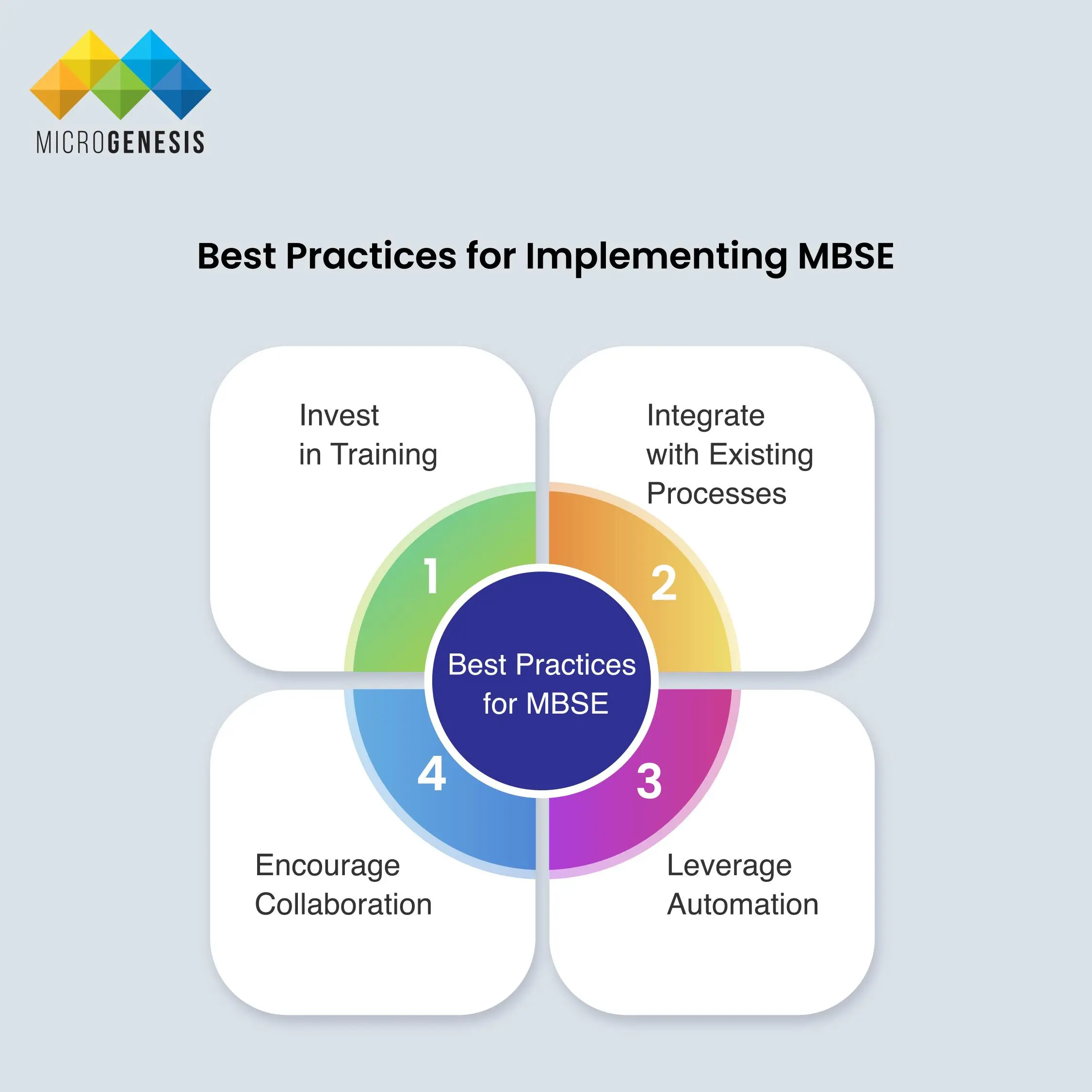
Learn more about Model-Based Systems Engineering (MBSE) in Automotive Engineering
Conclusion
Model-Based Systems Engineering (MBSE) represents a transformative approach to systems engineering, enabling more efficient, reliable, and consistent development of complex systems. By shifting from a document-based to a model-based approach, organizations can better manage system complexity, improve collaboration, and reduce development risks. As industries continue to adopt digital transformation strategies, MBSE is poised to become an integral part of modern engineering, driving innovation and efficiency across a wide range of sectors. MicroGenesis, with its expertise in implementing advanced engineering solutions, can play a pivotal role in assisting organizations with the successful implementation of Model-Based Systems Engineering (MBSE) tools. Here’s how MicroGenesis can help:
- Tool Selection and Customization
- Expert Guidance: MicroGenesis provides expert advice on selecting the most appropriate MBSE tools that align with your organization’s specific needs, industry standards, and existing infrastructure.
- Customization: We tailor the chosen MBSE tools to fit your organization's unique processes and requirements, ensuring that the tool’s functionalities are fully leveraged to enhance system engineering practices.
- Integration with Existing Systems
- Seamless Integration: We ensure that the MBSE tools are seamlessly integrated with your current systems, including PLM (Product Lifecycle Management), ALM (Application Lifecycle Management), and other enterprise tools.
- Data Synchronization: Our team handles the synchronization of data across platforms, ensuring consistent and accurate information flow, which is crucial for maintaining the "single source of truth" in MBSE.
- Process Optimization
- Streamlining Workflows: MicroGenesis helps in optimizing and automating engineering workflows using MBSE tools, reducing manual effort, and minimizing errors.
- Best Practices Implementation:We implement industry best practices in MBSE, helping your team adopt and adapt to new methodologies efficiently.
- Training and Support
- Comprehensive Training: Defines the business strategy and processes
- Ongoing Support: MicroGenesis provides continuous technical support and troubleshooting to ensure that the tools operate smoothly and any issues are resolved quickly.
- Consultancy and Model Development
- Scalable Solutions: We design MBSE solutions that can scale with your organization’s growth, allowing for easy updates and expansions as your system engineering needs evolve.
- Future-Proofing: MicroGenesis stays ahead of industry trends and technological advancements, ensuring that your MBSE tools remain relevant and effective in the long term.
- Consultancy and Model Development
- Standards Alignment: MicroGenesis ensures that your MBSE implementation adheres to relevant industry standards (such as ISO, IEEE, and others) and regulatory requirements, particularly in sectors like automotive, aerospace, and medical devices.
- Verification and Validation: We help set up rigorous verification and validation processes within the MBSE framework, ensuring that the models meet all specified requirements and are aligned with compliance needs.
- Scalability and Future-Proofing
- Scalable Solutions: We design MBSE solutions that can scale with your organization’s growth, allowing for easy updates and expansions as your system engineering needs evolve.
- Future-Proofing: MicroGenesis stays ahead of industry trends and technological advancements, ensuring that your MBSE tools remain relevant and effective in the long term.
- Collaboration and Communication Enhancement
- Improved Collaboration: We enhance collaboration across teams by setting up shared modeling environments where all stakeholders can contribute, review, and align on system models.
- Effective Communication: By integrating MBSE tools with communication platforms, we ensure that all team members, from engineers to management, have access to real-time updates and insights, fostering better decision-making.
Services
Related posts
Automation in Jira Product Discovery: Save Time & Reduce Manual Work
In fast-moving product organizations, time is a scarce resource. Product managers, engineers, and cross-functional teams spend a significant portion of their...
What is XLNC? Your Managed Service Platform for Atlassian and Beyond
In today’s agile and fast-moving business world, organizations rely heavily on tools like Jira, Confluence, Bitbucket, and various DevOps platforms to...
Automating Routine Tasks in Jira with XLNC
Modern teams thrive on agility, speed, and efficiency. However, managing Jira projects manually can lead to repetitive tasks, errors, and...


